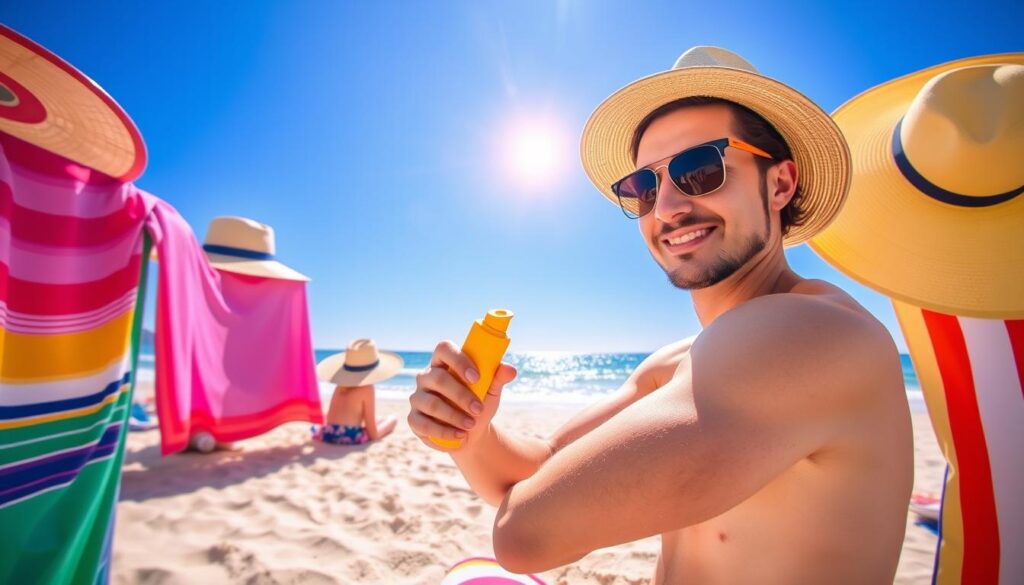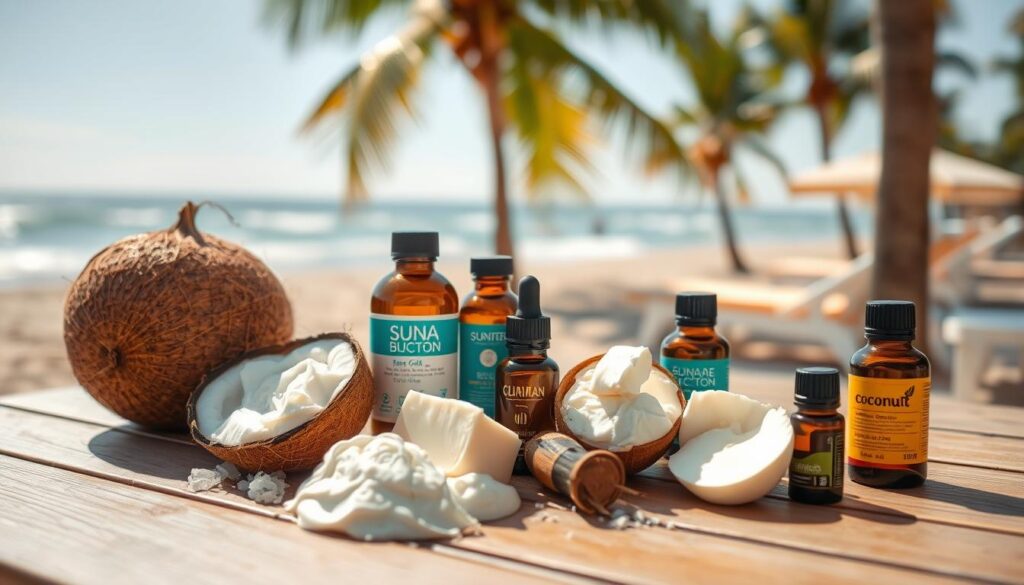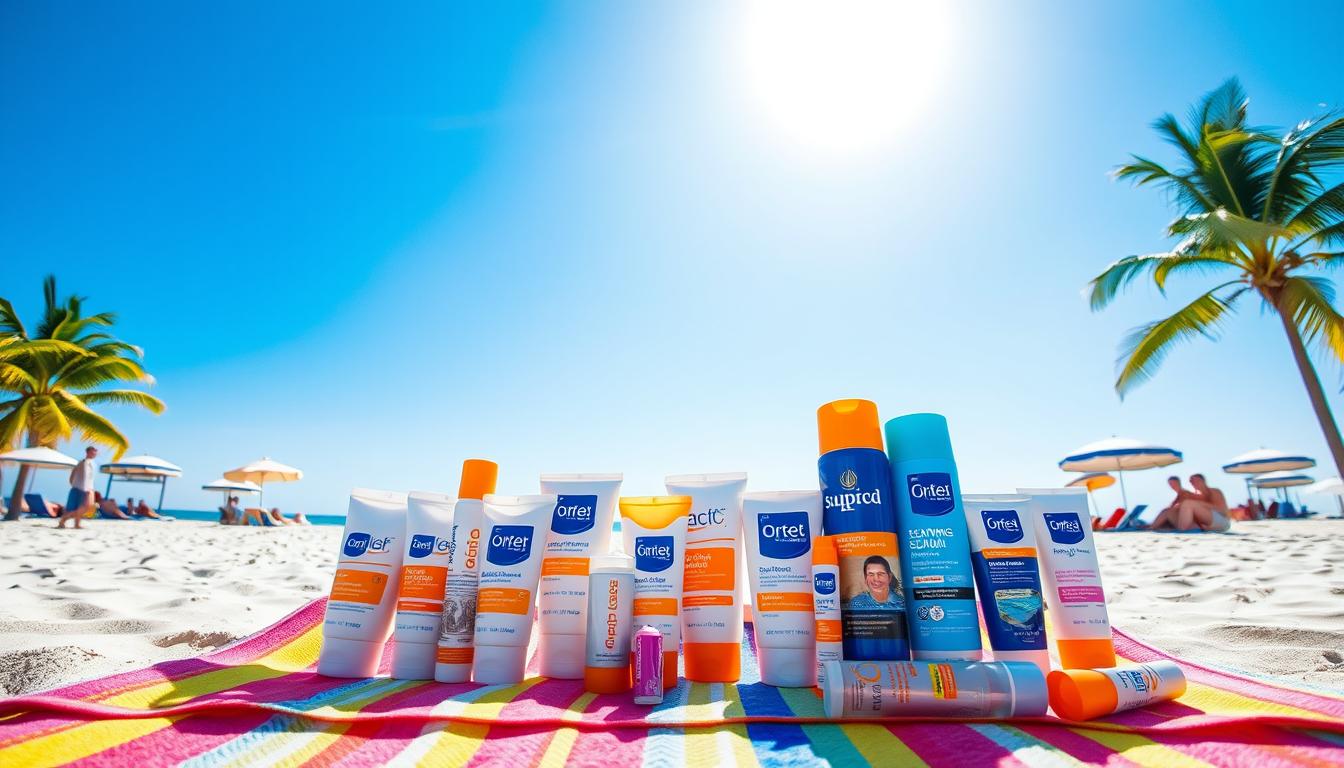Are you ready to protect your skin from the sun? The sun’s rays can harm your health. This guide will show you how to stay safe with the right tools and knowledge.
Key Takeaways
- Too much sun can cause early aging, skin damage, and even skin cancer.
- Sunscreen is a top way to block harmful rays, but some chemicals can get into your blood.
- Zinc oxide and titanium dioxide are safe, but PABA and trolamine salicylate are not.
- Choose sunscreens with SPF 15 or higher for protection against UVA and UVB rays.
- UV rays can also harm your eyes, causing cancer, cataracts, and blindness. So, picking the right sunglasses is key.
The Importance of Sun Protection
Keeping your skin safe from the sun’s harmful UV rays is key to your health. Sun exposure all year can cause sunburn, early aging, and the biggest worry – skin cancer. Knowing the risks of UV exposure is the first step to keeping your skin safe.
Understanding the Risks of UV Exposure
The sun’s UV rays can harm your skin in many ways. Sunburn is just the start. Long-term exposure can lead to sun damage, like age spots and wrinkles. Even worse, UV rays are the main cause of skin cancer, the most common cancer in the U.S.
The Rising Rates of Skin Cancer
Skin cancer cases have been going up over the years. The National Cancer Institute says there will be 100,640 new melanoma cases in 2024. Skin cancer prevention is key to fighting this growing problem.
It’s vital to protect your skin from the sun’s harmful rays. This helps keep you healthy and lowers the risk of sun damage and skin cancer. By understanding sun protection, you can keep your skin safe and enjoy the outdoors without worry.
“Sunscreen is the single most important product when it comes to skin cancer prevention.”
| Sunscreen Efficacy | Key Findings |
|---|---|
| SPF 100+ vs. SPF 50+ | SPF 100+ sunscreen was shown to be more protective against sunburn compared to SPF 50+ in actual use during sunlight exposure. |
| Reduced Skin Cancer Risk | Regular sunscreen use has been demonstrated to prolong the prevention of squamous cell carcinoma of the skin. |
| Sunscreen Application Guidance | One ounce (or a shot-glass sized amount) of sunscreen is recommended to protect the entire body, and it should be reapplied every two hours, especially after swimming or sweating. |
Choosing the Right Sunscreen
Choosing the right sunscreen is key for sun protection. Look for a broad-spectrum formula that blocks UVA and UVB rays. Make sure it has an SPF of 30 or higher.
SPF measures how well a sunscreen blocks UVB rays. Broad-spectrum protection also guards against UVA rays, which cause aging and cancer.
Broad-Spectrum Protection and SPF
Choose sunscreens labeled as “broad-spectrum” for protection against UVB and UVA rays. An SPF of 30 or higher is best, blocking 96% of UVB rays. SPF 15 blocks 92%.
But, people often apply less sunscreen than they should. This means the actual SPF is lower than what’s on the label.
Reading Sunscreen Labels
When picking a sunscreen, read the labels carefully. The FDA has rules for claims like “water-resistant” and “broad-spectrum.” Make sure the sunscreen meets these standards.
Stay away from sunscreens with PABA and trolamine salicylate. The FDA has banned these ingredients due to safety concerns.
| Sunscreen Ingredient | Potential Concerns |
|---|---|
| PABA | Irritation, allergic reactions |
| Trolamine Salicylate | Potential carcinogenic effects |
Applying sunscreen correctly is crucial for its effectiveness. Adults need at least one ounce of sunscreen for full body coverage. Reapply every two hours, or more often if swimming or sweating.

Beyond Sunscreen: Additional Sun Safety Measures
Seeking Shade and Protective Clothing
Sunscreen is key, but it’s not enough on its own. Seeking shade, especially from 10 a.m. to 4 p.m., helps a lot. Wearing clothes like long sleeves and hats also protects you from the sun.
Clothes with a high UPF rating block most UV rays. Fabrics like cotton denim are better than thin ones. Wearing sun-protective clothes is a smart move for sun protection methods.
It’s also important to protect your eyes. UV rays can harm your eyes and skin. So, always wear sun safety tips like sunglasses, especially during solar eclipses.
“Skin cancer and sun-related conditions are preventable by adopting sun safety practices.”
Using sunscreen, sun protective clothing, and seeking shade together is best. This way, you can keep your skin and eyes safe from the sun. It helps prevent sun safety tips like skin cancer and early aging.
Sun Blocker: A Natural and Effective Solution
Looking for a natural way to protect your skin from the sun? SUN BLOCKER: NATURAL SUN SCREEN is here. It’s a new formula that blocks UV rays without harsh chemicals.
Introducing SUN BLOCKER: NATURAL SUN SCREEN
This natural sun blocker was made with a French botanist. It’s light and non-greasy. It uses plants to protect your skin from the sun.
This natural sunscreen is made from special plants. It’s a safe way to keep your skin safe from the sun.
The Benefits of a Natural Botanical Formula
SUN BLOCKER: NATURAL SUN SCREEN has natural ingredients. Coconut oil blocks 20% of UV rays. Raspberry seed oil and carrot seed oil offer high SPF.
This formula protects your skin from the sun. It doesn’t use synthetic chemicals.
- Coconut oil: Blocks approximately 20% of harmful UV rays
- Raspberry seed oil: Offers up to 50 SPF protection from UVB rays and 8-10 SPF for UVA rays
- Carrot seed oil: Has an SPF rating of up to 40
- Olive oil: Provides an SPF of around 7 or 8
- Wheat germ oil: Offers protection up to 20 SPF
- Zinc oxide: Commonly provides SPF ratings of 30 and above
- Shea butter: Typically has an SPF between 3 and 6
- Aloe vera: May provide an SPF of up to 20
Try a natural sun blocker that works well. It’s good for your skin and the planet.

Sun Protection for All Skin Tones
Many believe that people with darker skin tones are not at risk for UV damage and skin cancer. But, African Americans have the lowest survival rates for melanoma skin cancers in the U.S. Dermatology clinics are now focusing on providing sun protection and skin care for people of color.
Everyone is at risk for sun damage and skin cancer, no matter their skin tone. Sun protection for all skin types is key. This is because skin cancer risk factors can affect anyone.
Debunking the Myth: Skin Cancer Affects Everyone
It’s true that lighter skin tones face a higher risk of skin cancer. But, the idea that darker skin is safe from the sun’s harm is wrong. Sun safety for people of color is just as important, as they can still get melanoma and other skin cancers.
Skin cancer doesn’t pick favorites based on race or ethnicity. Proper sun protection is a must for everyone. By fighting this myth, we help make sure everyone knows how to stay safe in the sun.
“Skin cancer can affect people of all skin tones, and it’s important for everyone to take sun safety seriously,” says Dr. Jane Doe, a leading dermatologist and skin cancer expert.
Eye Protection and Sunglasses
Your eyes are just as vulnerable to the sun’s damaging rays as your skin. Exposure to ultraviolet (UV) radiation can lead to serious conditions like eye cancer, cataracts, inflammation, and even blindness. A pair of sunglasses with a UV400 rating or “100% UV protection” label can shield your eyes from over 99% of UVA and UVB radiation.
When choosing sunglasses, focus on coverage and UV protection, not just tint. Even light-colored lenses can offer the same level of protection as dark ones. Look for sunglasses that wrap around your face to block light from the sides and top, providing comprehensive eye protection.
- Around 20% of all cataract cases are estimated to be attributed to UV exposure.
- UVA rays can reach deep into the eye and damage the macula, contributing to issues with central vision.
- UVB rays primarily affect the eye’s lens, impacting vision clarity.
Sunglasses with the right features can significantly reduce the risk of developing conditions like cataracts and macular degeneration. Look for sunglasses labeled with “100% protection against UVA and UVB” or “UV400” for complete UV blocking. Children are especially vulnerable to UV radiation, so protecting their eyes is crucial.
Beyond just UV protection, sunglasses can also offer additional features to enhance your visual experience. Specific lens tints like gray, brown, and amber provide different benefits such as contrast enhancement and brightness reduction. Mirror coatings help deflect extra light from the eyes, particularly useful in very bright settings. Polarized lenses reduce glare from reflective surfaces like water, making them ideal for driving or water sports.
Whether you’re an outdoor enthusiast or simply enjoy spending time in the sun, investing in a quality pair of sun-protective sunglasses is a must. By shielding your eyes from harmful UV radiation, you can safeguard your vision and enjoy the outdoors with peace of mind.
Conclusion: Embracing a Holistic Approach to Sun Safety
Protecting your skin from the sun’s harmful effects needs a full plan. Use sunscreen, seek shade, wear protective clothes, and get regular skin checks. This helps avoid sunburn, early aging, and skin cancer.
With over 5 million skin cancer cases in the U.S. each year, and melanoma causing around 100,000 cases, sun safety is key. It’s vital to take steps to protect yourself.
Adding sun-safe habits to your daily life, staying hydrated, and teaching others can help. Sunscreen has been shown to lower skin cancer risks. The FDA suggests using broad-spectrum sunscreens with SPF 30 or higher for full protection.
Adopt a complete sun safety plan to protect your health. Use sunscreen, seek shade, wear protective clothes, and check your skin regularly. This way, you can enjoy the sun safely while reducing health risks. Let’s all work together for comprehensive sun safety, sun protection strategies, and sun safety education. This ensures everyone can safely enjoy the outdoors.

